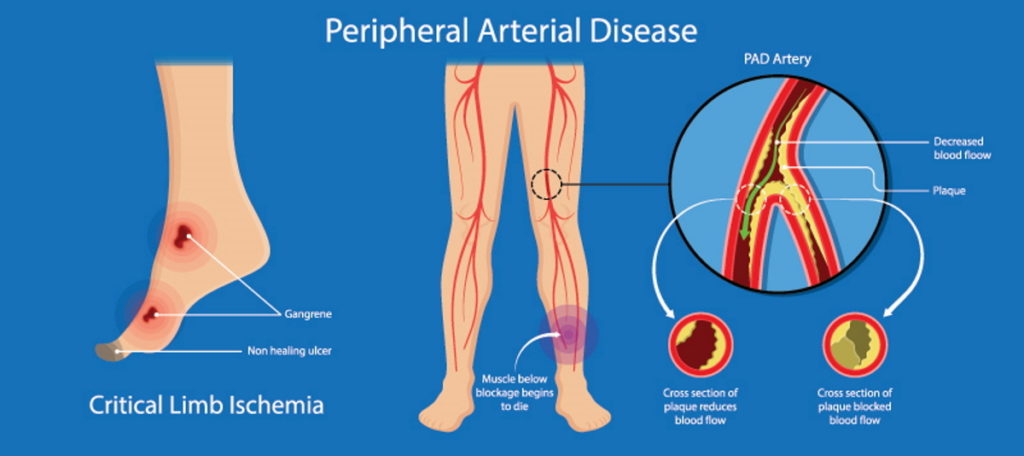PAD Awareness Month Sheds Light on Peripheral Artery Disease
Author: StrideCare Internal Team

Are You Experiencing These PAD Symptoms?
- Painful cramping in the legs or hips, especially while active but feel better at rest
- Changes in the appearance of extremities (color, loss of hair, shiny skin)
- Cold legs and feet
- Thickening of the toenails
- Open sores that don’t heal
- Dry, scaly, flaky, or leathery skin
- Erectile dysfunction
- No pulse or weak pulse in legs and feet
Why PAD Awareness Month Matters
Peripheral artery disease—also known as arteriosclerosis, peripheral arterial disease, or peripheral vascular disease (PVD)—is a condition where plaque buildup on the walls of blood vessels causes them to narrow and lead to poor blood circulation to the kidneys, intestines, arms, legs, and feet. When this happens, not only does a person experience the symptoms above, but they are at risk for coronary artery disease, heart attacks, or strokes. The scary part about peripheral artery disease is that while symptoms can vary widely, up to 4 in 10 people don’t even have symptoms at first. Others may have minor leg discomfort or fatigue that is chalked up to osteoarthritis or neuropathy.

This is why PAD Awareness Month is so important. Peripheral artery disease is life-threatening if left ignored, misdiagnosed, or unchecked. Any significant blockages that restrict blood flow to your limbs or organs can cause irreparable damage over the long term, including gangrene that leads to amputation. And yet, many people simply have not heard of PAD.
Ways that you and healthcare providers can observe PAD Awareness Month include:
- Increase PAD awareness through articles and resources
- Share common risk factors
- Improve access to PAD screenings and treatments
- Reduce care costs, where possible
- Continue fundraising initiatives
- Encourage someone you know to get checked
- Share stories and testimonials by those impacted by PAD
Are You at Risk for Peripheral Artery Disease?
The good news with peripheral artery disease is that it is treatable. But it is crucial—especially during PAD Awareness Month—to empower people to be more aware of the common risk factors and to change their lifestyle habits.
While anyone can get PAD, it is more prevalent when these factors exist:
Age — According to the CDC, the prevalence of peripheral artery disease skyrockets in older people, starting around age 40 and sharply increasing at 70 and older.
Ethnicity — Black Americans have an increased risk of PAD, though the reason for the PAD excess among them is not clear. Hispanics may have similar to slightly higher rates of PAD compared with non-Hispanic white people.
Poor diet — Improving your diet improves overall blood circulation, weight loss, and cardiovascular health. Options include fruits and vegetables, foods high in Vitamin C and E, and fiber-rich foods.
Smoking and diabetes — While obesity is a considerable risk factor, up to 80% of patients with PAD are current or former smokers. Also, roughly 20-30% of people diagnosed with PAD also have diabetes, which raises your risk of getting PAD and can also worsen the condition.
Hypertension — Sustained high blood pressure greater than 120/80 can harm your arteries and make you more susceptible to PAD. Approximately 35-55% of patients with PAD also show hypertension.
High cholesterol — The higher your bad cholesterol is, the greater chance of developing blocked arteries as a result of larger amounts of plaque buildup.
Inactivity — This study confirms previous research that links physical inactivity to an increased risk of PAD. Your circulatory system is not flowing blood from your heart to your legs and back to your heart if your legs are not moving. Therefore, maintain an active lifestyle to lower your risk for PAD.

Your doctor may suggest minimally invasive treatments to help you successfully beat PAD. Our vascular experts generally call on three procedures in these situations.
- Angioplasty — A balloon system that uses a catheter to open up narrowed or blocked arteries.
- Atherectomy — Advanced laser technology that clears away built-up plaque on large blood vessels.
- Stenting — This involves a small mesh tube to keep closed-off blood vessels open for the long term.
StrideCare Promotes PAD Awareness Year Round
Peripheral artery disease can sound scary, especially when you consider the symptoms you may be facing and the constant awareness messages during PAD Awareness Month. But as stated earlier, PAD is highly treatable when caught early, and it is possible for you to lead a normal and healthy life.
Our expert vascular doctors and highly skilled team members at StrideCare are proud to offer surgical and non-surgical treatments for vein and artery diseases. We only utilize the latest technologies and minimally invasive procedures. On top of that, our physicians are board-certified diagnostic radiologists with additional fellowship training in vascular and interventional radiology. That means we are the best at what we do!
Prior to starting any new treatment or questions regarding a medical condition, always seek the advice of your doctor or other qualified health provider. This information is not a substitute for professional medical advice.
StrideCare serves the South Texas area including Houston, San Antonio, Austin, Round Rock, Bastrop, Brushy Creek, Cedar Park, Converse, Georgetown, Hutto, Kyle, Leander, Marble Falls, New Braunfels, Pasadena, Pearland, Pflugerville, San Marcos, Schertz, Houston, Sugar Land, Katy, Webster, Bay City, Clear Lake, Lake Jackson, The Woodlands, Universal City, Spring, Kingwood, Stafford, Conroe, Texas City, Cypress, League City, Bellaire, and more.


